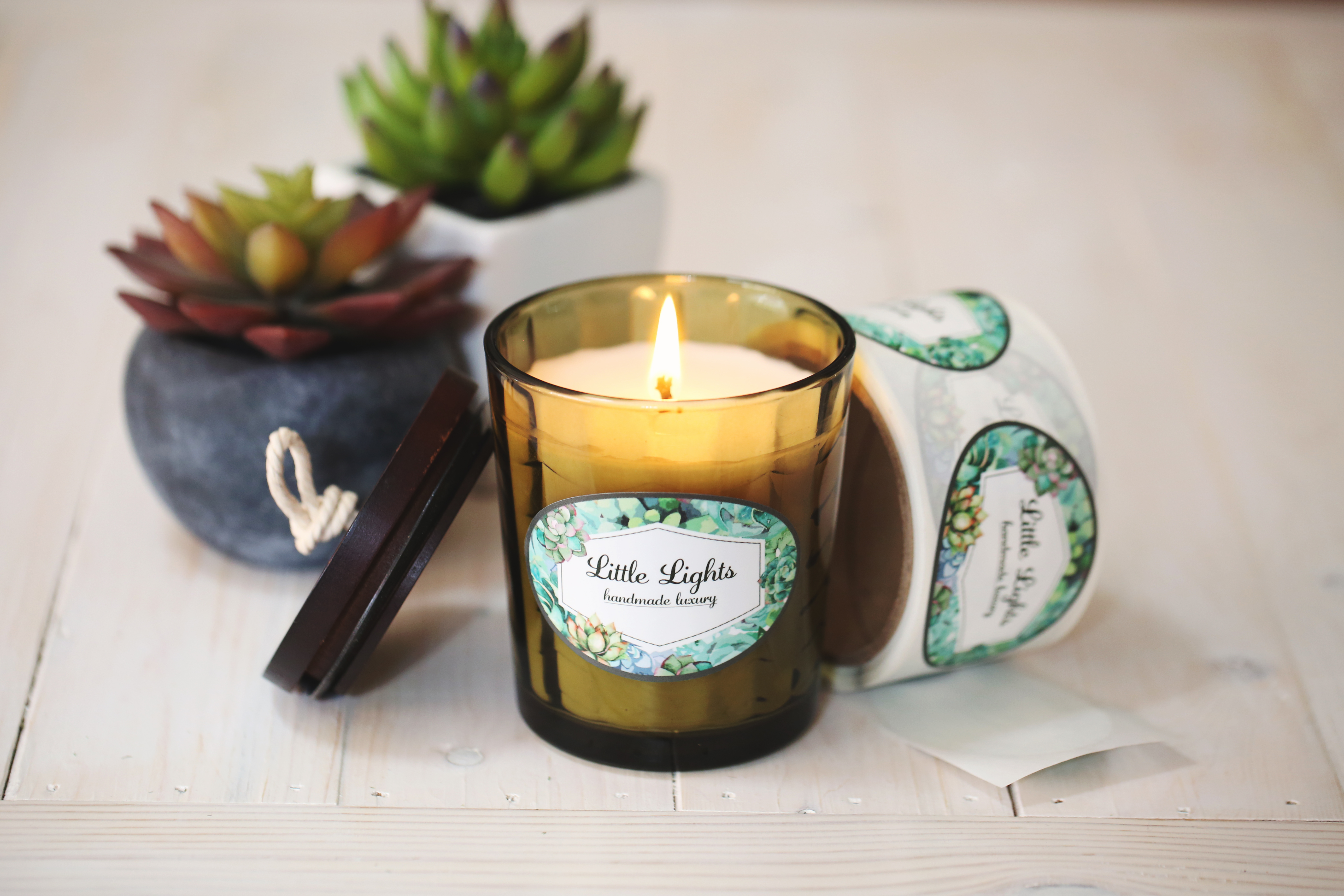Cómo montar un negocio de velas en casa: Guía paso a paso
Publicado por Alberto Queiroz el
¿Quién podría haber predicho que las velas, de entre todas las cosas, aumentarían su popularidad en 2023?
Nuestra era es la de la iluminación abundante, como puede verse en una imagen del mapa de contaminación lumínica de la Tierra. Pero ni siquiera las superbaratas y omnipresentes lámparas LED que iluminan nuestros interiores han conseguido acabar con la humilde vela de nuestros hogares.
Esta invención de 5000 años de antigüedad dejó de ser relevante para la iluminación y encontró un nuevo propósito en la decoración y el estilo de vida. Las tendencias modernas de decoración del hogar y las prácticas de bienestar como la aromaterapia han alimentado la demanda de velas artesanales y perfumadas, una tendencia agravada por el auge de las tendencias de bienestar inspiradas en la pandemia entre los millennials.
Con un mercado mundial de velas de 12.880 millones de dólares y una tasa de crecimiento prevista del 5,7% de 2023 a 2030, la popularidad de las velas está más lejos que nunca de desaparecer y el momento es propicio para los aspirantes a vendedores de todo el mundo.
¿Quieres saber cómo empezar un negocio de velas en casa? Entonces enciende una vela y sigue leyendo mientras te ofrecemos un resumen de los principales pasos para poner en marcha un negocio de velas.
1) Escoge tu nicho
Antes de empezar con tu negocio de velas, determina cuál será tu nicho. Lo mejor es empezar poco a poco y hacer una cosa bien, manteniendo la alternativa de expandirse a otros tipos de velas más adelante.
Principales tipos de velas
Como bien saben los aficionados a las velas, las hay de diversas formas, tamaños, aromas y materiales. Repasemos cuatro tipos comunes.
Velas aromáticas
Las velas aromáticas son una forma estupenda de aliviar el estrés y crear un ambiente relajante. Junto con los aceites esenciales, constituyen el núcleo de la aromaterapia y también han ganado popularidad a medida que pasamos más tiempo en casa y nos preocupamos más por cómo huelen nuestros espacios vitales.
Las investigaciones han llegado incluso a demostrar que los olores adecuados pueden aumentar nuestra productividad. Todo esto convierte a las velas aromáticas en un gran nicho para la fabricación de velas.
Velas decorativas
Todas las velas son muy versátiles a la hora de decorar, pero puedes optar por hacer velas dirigidas a un tipo de decoración o estilo especial. Las velas decorativas, como las que se utilizan en las tendencias hygge, suelen ser inodoras, ya que están pensadas para ser sólo una pequeña parte del ambiente de tu hogar.
Si decides trabajar con velas decorativas, te resultará una oportunidad perfecta para jugar con las formas y los colores. Incluso puedes optar por hacer velas para eventos estacionales especiales, como velas naranjas con forma de calabaza para Halloween o verdes con forma de pino para Navidad.
Velas de cera de abeja
Las velas de cera de abeja constituyen un nicho especial -y caro- en el mundo de los vendedores. El alto punto de fusión de la cera de abejas hace que estas velas duren más que las de parafina normales, pero ésa no es ni de lejos su única ventaja. Las velas de cera de abeja desprenden menos hollín y emiten más luz, además de no tener un olor fuerte, lo que las hace perfectas para un ambiente acogedor y relajado.
También se dice que la cera de abeja tiene un efecto positivo en la calidad del aire de la casa: al arder, la vela libera iones negativos que neutralizan varios contaminantes atmosféricos.
Lo que hay que tener en cuenta es que la cera de abejas es un material más caro, que puede requerir una planificación y un aprovisionamiento más cuidadosos.
Velas de soja
Las velas de soja pertenecen a la categoría de las llamadas "ceras felices", es decir, ceras no contaminantes fabricadas con materiales naturales. Al no quemar parafina derivada del petróleo, su llama es más limpia, con un mejor impacto tanto en tu salud como en el medio ambiente. Además, proceden de la soja, lo que las hace mejores para el medio ambiente.
Al igual que la cera de abeja, las velas de soja duran más que las de parafina. Si a esto le añadimos que son "ecológicas", tenemos un buen nicho de clientes preocupados por el medio ambiente.
2) Crear una propuesta única de venta
Una Propuesta Única de Venta (o USP, por sus siglas en inglés) consiste esencialmente en decir a tus clientes por qué tu producto merece su atención y su dinero: por qué deberían comprártelo a ti y no a la competencia.
Una USP es esencial para cualquier negocio, y por una buena razón: tener un buen producto no significa nada si no puedes convencer a tu cliente para que lo adquiera.
Para formular una USP convincente:
- Identifica tu mercado objetivo. Comprende qué grupo demográfico es probable que compre tu producto. En el caso de las velas de cera de abeja, podría tratarse de mujeres millennials de clase media preocupadas por el medio ambiente.
- Determina qué hace que tu producto sea único. Este será el punto central de tu marketing para ese público. Volviendo a la cera de abeja, es única porque es respetuosa con el medio ambiente, dura más y es un producto tradicional y atemporal.
- Escribe una USP que destaque estas ventajas de forma clara y concisa.
- ¡Promociona! Tu USP puede ser el punto central de la página "Acerca de" de tu empresa, de tu eslogan e incluso de tu logo.
3) Desarrolla tu línea de productos
Una empresa es tan buena como el producto que vende. Una vez que hayas llegado a tu punto de venta único, es hora de desarrollar tu línea de productos para que cumpla y supere las expectativas de tus clientes.
Aquí querrás experimentar con los muchos aromas, colores y estilos de velas disponibles, encontrando materiales de alta calidad para cada aspecto de tu línea de velas. Las combinaciones son prácticamente infinitas y, con suficiente planificación y pruebas, pronto estarás en camino de crear tu propia marca de velas.
Piensa detenidamente en cada uno de los elementos de tus velas.
Ceras
Ya vimos lo importante que es elegir la cera adecuada para el nicho de tus velas. Entre los tipos de ceras para velas a tener en cuenta, tenemos:
- Cera parafínica: También conocida como cera mineral, es más barata, más fácil de conseguir y mejor para fragancias fuertes. Sin embargo, se quema más rápido, desprende hollín y procede de petróleo no renovable.
- Cera de soja: Una alternativa ecológica perfecta a la parafina, aunque menos propicia a los olores. Quema muy bien, con poco hollín.
- Mezcla de parafina y soja: Las mezclas se utilizan a menudo para reunir los beneficios de dos materiales, como en el caso de las velas aromáticas de mezcla de parafina y soja de combustión lenta.
- Cera de abejas: El tipo de material para velas que mejor se quema, también es uno de los más caros.
- Cera de coco: Otra alternativa cara, pero ecológica, que se presta bien a diferentes mezclas.
Mechas
Las mechas pueden elegirse en función del tipo de cera o de recipiente utilizado, o simplemente por razones estéticas. Los principales tipos de mechas son los siguientes.
- Planas: El tipo más común en velas cónicas y pilares, las mechas planas se componen de dos o tres hebras de fibra tejidas juntas. Se enroscan en la llama para conseguir un efecto de recorte sin esfuerzo.
- Cuadradas: Las mechas cuadradas trenzadas se utilizan a menudo con cera de abeja, ya que se obstruyen menos que otros tipos de mechas.
- Con núcleo: Las mechas con núcleo se trenzan alrededor de una pieza central, normalmente de algodón, zinc o papel, que ayuda a mantenerlas erguidas. Son populares en velas de tarro y votivas.
- De madera: Hechas de madera o combinaciones de fibra de madera y algodón, estas mechas han ganado popularidad debido a su efecto estético y al suave sonido crepitante que producen.
Fragancias
Un sentido poderoso, pero lamentablemente infrautilizado, el olfato se procesa de forma diferente a cualquier otro sentido - que es sólo una de las razones de la popularidad de las velas aromáticas. Bien utilizadas, las fragancias adecuadas ayudan a dar forma a momentos inolvidables; tus velas aromáticas pueden despertar emociones vívidas y conectarse con recuerdos preciosos.
Las fragancias de las velas también son una forma brillante de crear un ambiente de relajación o una atmósfera de concentración, entre otros muchos usos, todos los cuales debe tener en cuenta a la hora de elegir, mezclar e inventar tus propias fragancias.
No olvides nombrar tus fragancias de forma original y memorable. Puede ser una buena forma de reforzar las asociaciones de marca, diferenciar tu línea de productos y explorar tu creatividad.
Contenedores
Los contenedores que utilices para tus velas también deberían depender de tu mercado objetivo y del estilo general que busques. Los tarros Mason o de mermelada tienen un atractivo más rústico, mientras que los tarros tumbler pueden dirigirse a un público con gustos más refinados. Del mismo modo, los colores que emplees también deben estar en consonancia con tu marca general, el tipo de vela y el mercado.
4) Marca y packaging
La marca es un aspecto clave de tu negocio de velas a domicilio: puede ser el elemento decisivo que haga que los clientes elijan tu tienda entre multitud de otras y hagan que vuelvan.
Aunque la imagen de marca no tiene por qué requerir mucho tiempo y esfuerzo, sí debe estar bien planificada. Desea transmitir una imagen y un mensaje coherentes que se graben firmemente en la mente de los compradores, y esto implica prestar atención a algunos elementos clave.
Diseñando tu logo
Tu logotipo es la tarjeta de presentación de tu marca. Puede ser sencillo o elegante, pero debe ser memorable y estar en sintonía con el aspecto general de la marca. Si necesitas ayuda para diseñar tu logo, puedes consultar algunas de las muchas plantillas disponibles en nuestra herramienta de diseño gratis Studio.
Hacer un buen uso de las etiquetas para velas
Las etiquetas para velas pueden ser un elemento de marca clave que bien merece tu tiempo y atención. Además de compartir tu logo y tu marca con el mundo, también ayudan a crear el ambiente general que buscas: rústico, refinado, moderno o clásico.
Elegir el packaging adecuado
El packaging es otro factor que a menudo se pasa por alto, pero que es fundamental para la imagen de marca. Los factores que hay que tener en cuenta son los siguientes
- Material de packaging: Cajas, bolsas de papel y sobres son algunas de las opciones más comunes.
- Personalización: ¿Cómo hacer que tu packaging destaque? Entre otras ideas, las etiquetas personalizadas y la cinta de embalaje personalizada pueden ayudar mucho a crear una imagen de marca única.
- Precios: Un factor importante para las empresas domésticas. Pero no te preocupes, ¡hay muchas formas de utilizar material de packaging único y personalizarlo sin salirse del presupuesto!
5) Establece tu presencia en Internet
Ahora que ya tienes claro tu nicho, tu línea de productos y los elementos de tu marca, es el momento de asegurarte de que los clientes saben dónde encontrarte. Para ello, puedes crear tu propio sitio web u optar por una plataforma de comercio electrónico.
Crear un sitio web
Tener tu propia página web te independiza de otras plataformas y es un signo de profesionalidad, pero también requiere un poco más de esfuerzo. Tendrás que registrar (y pagar) tu propio dominio y elegir un diseño web para tu sitio: algo que puedes construir tú mismo, comprar un tema prediseñado, o simplemente pagar a un autónomo en plataformas de subcontratación como Upwork para que lo haga por ti.
Para vender en tu propio sitio web, puede que necesites integrarlo con un plugin para sitios web de comercio electrónico. Las opciones más populares son:
- Woocommerce: Un plugin de código abierto para sitios web basados en Wordpress, Woocommerce es completamente libre de usar y puede ser una gran manera de administrar su propio sitio web.
- Bigcommerce: Bigcommerce es una plataforma de comercio electrónico todo en uno con una gran pila de temas personalizables, gestión de productos, procesamiento de pedidos, integraciones de pasarelas de pago y herramientas de marketing para tiendas online. Los planes de precios empiezan en unos USD 40/mes.
- Magento: También de código abierto, Magento ofrece temas personalizables, gestión de productos, procesamiento de pedidos, servicio de atención al cliente y herramientas de marketing para sitios web de comercio electrónico. Es ideal para los técnicos que quieren poder hacerlo todo, pero puede resultar engorroso para los demás. Los precios varían en función de los servicios que se utilicen.
Utilizar una plataforma de comercio electrónico
Una plataforma de comercio electrónico puede ayudarte a establecer una presencia temprana en el mercado y ahorrarte el trabajo de crear un sitio web. Vender a través de una plataforma como Etsy también puede ayudarte a labrarte una reputación gracias a las opiniones de los usuarios, además de facilitarte el proceso de pedido — lo cual es una gran noticia en caso de que estés empezando tu empresa en solitario y no dispongas de mucho tiempo libre.
Por otro lado, las plataformas suelen descontar una tarifa fija o un porcentaje de tus ingresos por ventas, así que tenlo en cuenta. En el caso de Etsy, es el 6,5% de cada transacción.
Crear perfiles en las redes sociales
Las redes sociales son una fuerza creciente en el panorama del comercio electrónico, y una valiosa herramienta para tu negocio de velas a domicilio. Asegúrate de crear páginas en las principales redes sociales de tu país, como Facebook, Instagram, Twitter y TikTok.
Publicar regularmente en las redes sociales te ayudará a aumentar el número de seguidores, además de mostrar tus productos y proporcionar un canal para responder a las preguntas de los clientes y recoger sus comentarios.
SEO y estrategias de marketing de contenidos
Una vez que hayas puesto en marcha tu sitio web y hayas establecido tu presencia en las redes sociales, no olvides seguir publicando contenidos — así mantendrás tu relevancia y tu presencia ante los clientes.
Para la optimización de motores de búsqueda (SEO), puede ser una buena idea incorporar un blog a tu sitio web. Puedes publicar información sobre el lanzamiento de nuevos productos, datos interesantes, consejos prácticos o cualquier otra cosa relacionada con el mundo de las velas. Y asegúrate de publicar regularmente — al menos dos veces al mes.
Otra buena forma de estar en contacto con tus clientes es crear un boletín en el que compartas lanzamientos y promociones con tus suscriptores. Eso sí, procura no abusar de la frecuencia de tus correos electrónicos — dos a la semana como máximo.
6) Gestión de precios y envíos
Por último, pero no por ello menos importante, echemos un vistazo a dos aspectos clave de tu negocio de velas: los precios y los envíos.
Precios
Fijar el precio de tus productos puede ser bastante complicado al principio, pero pronto encontrarás el camino. Algunos elementos clave a tener en cuenta:
- Tu costo total en la fabricación de las velas. Esto incluye tu gasto medio por tipo de vela (incluido el packaging y el envío) + la inversión de tiempo. También deberías tener una idea de cuánto vale tu tiempo — cuál es el mínimo que este trabajo debería pagar por hora, así como tu objetivo de ingresos por hora.
- Tu mercado objetivo. Aquí volvemos al nicho elegido, ya que el poder adquisitivo de tus clientes objetivo también influye en tus estrategias de precios.
- Tu valor percibido es lo que la gente cree que valen tus productos en comparación con otros similares. Aunque será difícil evaluarlo cuando estés empezando, con el tiempo podrás tener en cuenta el valor percibido a la hora de fijar tus precios, a medida que construyas tu base de clientes y descubras cuál es tu posición frente a la competencia.
- La competencia. Todos los cálculos anteriores tienen que basarse en la realidad. Esto significa comprender el precio que aplica la competencia a sus productos y adaptar el precio en consecuencia.
Hay muchos otros aspectos relacionados con la fijación de precios que hay que tener en cuenta, como los precios de venta al por mayor, la conveniencia o no de ofrecer gastos de envío gratis, los descuentos por fidelidad, los códigos promocionales y mucho más. Pero no tienes por qué abordarlo todo a la vez; empieza por lo esencial y enriquece tu sistema de precios a medida que tu negocio crezca.
Envío y gestión de pedidos
No se puede pasar por alto la importancia de los envíos. Por un lado, el gasto y la rapidez de los envíos influyen directamente en la predisposición de los clientes a comprar en tu empresa. Por otro, debes tener en cuenta cuánto gasta en gestionar el envío de pedidos — tanto en dinero como en tiempo.
Teniendo esto en cuenta, asegúrate de planificar bien tu estrategia de envío. Una idea puede ser gestionar tus envíos a través de una plataforma de cumplimiento o envío, como Shipstation o nuestra propia herramienta gratuita: Ship, de Sticker Mule. Una plataforma de gestión le ayudará a agilizar sus envíos, lo que puede ser especialmente útil cuando se trata de un aumento de la demanda estacional (como la loca época punta de noviembre-diciembre). Nota: Ship solo está disponible en EE. UU.
Por último, recuerda que el envío es una oportunidad única para impresionar a tu cliente. En una reciente entrada de nuestro blog encontrarás formas de cautivar a tus compradores con una experiencia de envío memorable.
Recapitulemos
| Paso | Cosas por hacer |
|---|---|
| 1 | Escoge tu nicho |
| 2 | Crear una propuesta única de venta |
| 3 | Desarrolla tu línea de productos |
| 4 | Marca y packaging |
| 5 | Establece tu presencia en Internet |
| 6 | Gestión de precios y envíos |
Empezar tu propio negocio de velas desde casa puede parecer desalentador, pero no tiene por qué ser así. Ve paso a paso. Recuerda tener en cuenta tu nicho, planificar tu línea de productos y tu marca, establecer tu presencia en Internet y tener un plan bien pensado para los envíos y los precios.
Persigue tus sueños empresariales y descubrirás que no sólo es una forma factible de empezar a ganar dinero con lo que para muchos no es más que un hobby, sino que tu negocio de velas puede convertirse en el esfuerzo de pluriempleo que transforme la pasión en un medio de vida.






Comentarios